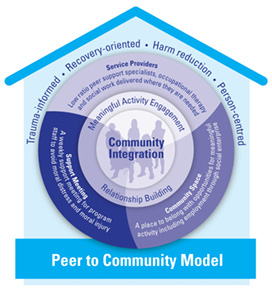More than housing is needed for persons leaving homelessness to thrive
By Kim McCready
Ending homelessness isn’t as simple as providing a roof over a head. Persons leaving homelessness need to thrive — meaning they need to grow their mental well-being, integrate into their communities, engage in meaningful activity and exit poverty. While securing housing is one very important step towards thriving, supports and services are often unable to meet the additional needs of this population.

Carrie Anne Marshall, School of Occupational Therapy
A new study conducted by Western University’s School of Occupational Therapy and Arthur Labatt Family School of Nursing — in collaboration with service providers and organizational leaders (SPOL), policy makers and persons with lived experience of homelessness — looks at what is needed to enable thriving following homelessness and informs the development of a novel intervention that supports community integration.
Led by Occupational Therapy professor Carrie Anne Marshall and published in Health & Social Care in the Community, the study specifically addresses the perspective of SPOL from two sites, Kingston and London, Ontario, as little academic literature to date has focused on SPOL input and evidence generated from a range of stakeholders is needed.
SPOL were interviewed regarding the strengths and challenges associated with existing supports in their respective communities and their perspectives on what individuals need to thrive following homelessness.
"Participants felt they know what is needed," says Marshall, "but they are caught in a system that prevents them from helping".
Support services are stretched thin, and SPOL can only work with individuals for a short amount of time, even when they believe support is needed for much longer. The system is overburdened, with few resources to support thriving beyond achieving tenancy, which has serious impact on the well-being of SPOL as well as persons leaving homelessness.
"Mitigation of loneliness is often a last priority and falls off the radar as most of the supports available do not address it or address it well," shares Marshall. "It shows a need for novel interventions to fill the gaps around community integration".
Persons experiencing or leaving homelessness often use substances as a coping strategy for dealing with trauma and living in less than dignified conditions. Substance misuse can create financial strain and intensify disruptive behaviours that lead to tenancy loss. Access to programs and supports that manage or prevent the harms of substance use are often limited in availability, but are vital to supporting persons leaving homelessness.
Participants in the study identified that persons leaving homelessness often struggle to pay for basic needs and that the housing available to them is inadequate. Living in conditions of ongoing need prevented individuals from thriving as they were forced to focus on survival.
A number of recommendations including mental health supports and trauma and violence informed care (TVIC) training for SPOL are indicated by the findings of the study.
The study's team of stakeholders also identified recommendations to address the structural barriers to thriving affecting persons leaving homelessness, while acknowledging that these are changes that would need to be made by policy makers who have already heard these suggestions before.
"Mainly people who are homeless are living in poverty and they really need a higher income," says Marshall. "Also, we need more deeply affordable housing. Not affordable housing generally, but housing that's affordable to individuals who are living on the lowest incomes in our society. We are adding to the choir of voices that are asking policy makers to make these changes."
On the streets, people experiencing homelessness often develop connections with others in similar situations, but once they receive housing, they often lose that sense of community. Developing new connections within their community is difficult without support.
"Mitigation of loneliness is often a last priority and falls off the radar as most of the supports available do not address it or address it well," shares Marshall. "It shows a need for novel interventions to fill the gaps around community integration".
Peer support services were identified as vital for promoting community integration and more positive outcomes. Persons leaving homelessness may better connect with peer support workers, identifying with them more easily than with other care professionals. Marshall and team emphasized the need to properly prepare, train, respect as a legitimate and skilled care provider, and fairly compensate those who perform a peer support role.
According to Marshall, the team has focused on co-designing an intervention they can implement and pilot that promotes community integration via a peer-to-community model. Informed by the findings of stakeholder consultation including both this study and a soon-to-be-published study on the perspectives of persons with lived experience of homelessness, the intervention includes a curriculum for peer support workers that they will receive in advance of providing service.
"The team sees this project very much as a homelessness prevention strategy, where we mean preventing on-going, chronic or recurring homelessness," says Marshall. "And what really strikes me in talking with people with lived experience of homelessness during this project has been how little they actually ask for. The just want a place to feel safe, that's clean, that doesn't have bed bugs and where they are warm enough and have some control over their level of comfort in their unit — basic living conditions that by virtue of their own birth they should be entitled to."
Occupational Therapy professor Debbie Rudman and Nursing professor Abe Oudshoorn collaborated on the design of this study and strategies for the analysis and interpretation of data.


